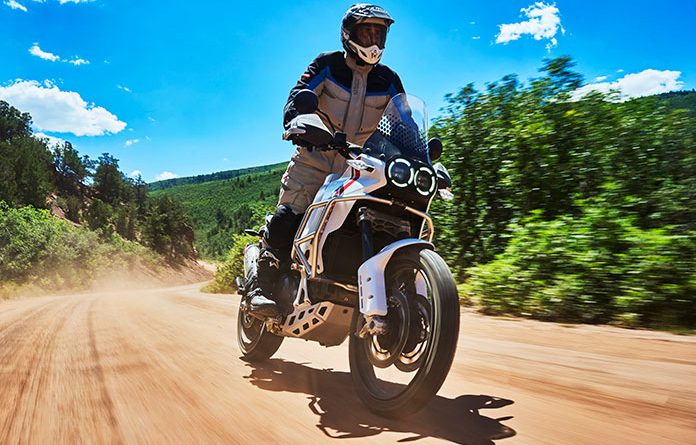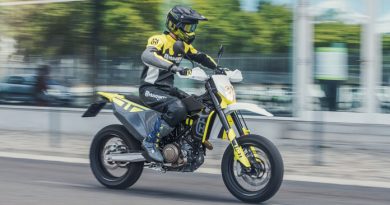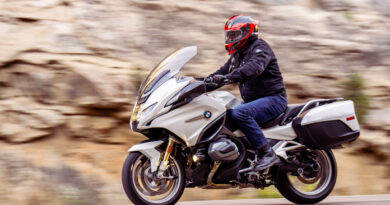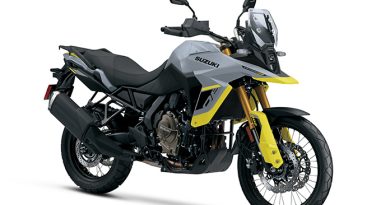2022 Ducati DesertX | First Ride Review
We got a first ride on the all-new Ducati DesertX in the Rocky Mountains of Colorado. Photos by Gregor Halenda and Scott Rounds.
Ducati knows how to build sportbikes and superbikes. The Italian manufacturer claimed 14 World Superbike championships between 1990 and 2011, and it has finished in the top three in MotoGP every year since it began competing in the premier class in 2003, including two championships. A lot of this racing experience transfers well onto the company’s streetbikes, and even its Multistrada models, which handle more like sportbikes than adventure bikes when ridden hard on pavement.
Enter the Ducati DesertX, the newest machine to leave the factory in Borgo Panigale, with a seemingly heavy penchant for unpaved surfaces. Styling-wise, the DesertX looks like it’s ready to tackle the Dakar Rally with a rally-inspired fairing, long-travel suspension, and off-road friendly wheel sizes.
At the bike’s North American launch held just outside Aspen, Colorado, Ducati reps admitted during the technical presentation that this machine took the company out of its comfort zone. Despite this declaration, Ducati has some off-roading lineage. Back in 1990, Italian rider Edi Orioli won the grueling Paris-Dakar rally aboard a Cagiva Elefant, a feat he repeated in 1994. Ducati was under Cagiva Group’s ownership from 1985 to 1996, and the Elefant was powered by a 900cc Ducati V-Twin.
A concept of the DesertX was first shown at EICMA in 2019, and it was met with a wave of enthusiasm. This prompted Ducati to pursue its development, and although the concept bike was based on a Scrambler 1100, the DesertX is almost entirely new from the ground up. Its engine is based on the Monster’s liquid-cooled 937cc Testastretta V-Twin, not on the Scrambler’s air-cooled 1,079cc mill.
It’s the same engine you’ll find in the Hypermotard, Multistrada V2, and Supersport, though it has been reworked for use in the DesertX. It claims 110 hp and 68 lb-ft of torque, and changes include dedicated ride and power modes. Gearing is shorter from 1st to 5th (6th was left unchanged for highway riding), with the lowest gears made especially short to handle tight off-road sections: 1st is 14% shorter and 2nd is 9% shorter than on the Multistrada V2. Valve-adjustment intervals are set at 18,000 miles.
The DesertX is the first modern Ducati to roll on a 21-inch front and 18-inch rear wheel combo, and the rims are cross-spoked and tubeless. This, of course, works better over rough terrain than other wheel combinations, and it offers a better selection of off-road tires. The Pirelli Scorpion Rally STR tires on the DesertX provide great traction on hard-packed and moderately soft dirt, as well as surprisingly tenacious, vibration-free grip on pavement. From previous experience with these tires, though, they’re not very good in sand and mud, but there are other options for that. You can opt for the aggressively treaded Scorpion Rally for more extreme off-road excursions or for the more street-oriented Scorpion Trail II tires, both of which are approved for the DesertX.
The DesertX is built on a steel trellis frame, with fully adjustable suspension by Kayaba that includes a 46mm inverted fork and a single shock with a remote preload knob located on the right side of the bike just below the seat. Suspension travel is ample, with 9 inches up front and 8.7 inches out back. The tall suspension provides abundant ground clearance, with 9.8 inches of space between the skid plate and terra firma.
Fuel capacity is 5.5 gallons, and a 2.1-gallon auxiliary tank ($1,500) is available. The optional tank is rear-mounted, and it feeds the main tank via a switch. When the fuel level in the main tank drops low enough to accept the additional 2.1 gallons, the rider is prompted to switch on the auxiliary tank through the instrument panel, and the extra fuel is then pumped into the main tank.
Out On the X
The DesertX proved itself more than capable of handling serious off-road excursions during our 85-mile test loop, of which about 85% was unpaved, and a good portion of that was rough, rocky, and in places quite steep. Our hosts had accessorized our test bikes, firstly to showcase a few of the goodies available from Ducati but also to help protect the bikes from damage that might be suffered over challenging terrain. Accessories included crash bars ($700), a larger skid plate ($500, mounted solidly to the frame via brackets rather than to the engine cases), and a Termignoni muffler, among a few other items.
Standard seat height is 34.4 inches, with an optional low seat ($308) dropping that to 34.1 inches. If you require an even easier reach to the ground, you can further drop the perch to 33.3 inches by combining the low seat with a lowering kit, which includes fork and shock springs and a shorter sidestand ($300). A taller seat is also available that raises height to 34.6 inches.
At 6 feet tall, I could get one foot flat on the ground and the other on my toes with the standard seat, which is narrow at the front to ease reach to the ground and widens considerably at the rear to give broad support. Unfortunately, I cannot comment on its long-term comfort since most of the day was spent standing on the footpegs off-road. The fairing protects your torso from most of the windblast, though the optional taller touring windscreen ($230) would probably be a good investment for longer highway stints.
The 5-inch TFT instrument display is mounted vertically, which is said to facilitate reading it while standing up, while also providing a better display when using the optional Bluetooth-enabled turn-by-turn navigation through your phone. Lean-sensitive ABS and traction control, wheelie control, adjustable engine braking, cruise control, and a quickshifter are all standard. The DesertX has four road modes (Sport, Touring, Urban, and Wet) and two off-road modes (Enduro and Rally), as well as four power levels, all selectable via the instrument panel. Enduro mode limits output to 75 hp, sets throttle response to dynamic, shuts off wheelie control, and reduces ABS intervention to level 2 (out of 3, rear ABS disabled) and traction control to level 3 (of 8).
Within minutes after turning off the pavement, the DesertX asserted itself more as a proper dual-sport machine rather than a ponderous adventure bike. My preferred off-road setting was Rally, which drops ABS intervention to minimum (still off at the rear) and traction control to level 2, though even this setting wasn’t ideal for a fast pace. Fortunately, all six ride modes are individually customizable, so I turned traction control off and selected the softer throttle setting than the standard dynamic setting.
My only gripe with the ride modes is how they are selected. You must hold down the mode button on the left-hand switch assembly for a couple of seconds to prompt the mode selection menu on the instrument panel and then scroll to the desired mode, hit the mode button again, and shut the throttle to confirm your selected mode. With practice it can be done in a matter of seconds while riding, but it’s a distracting and tedious process that could be simplified. On the bright side, the bike retains its selected ride modes anytime the ignition switch is turned off and on again.
With this tailored Rally setting selected, the rear end slid at will to ease cornering on dirt, and the front wheel lifted effortlessly to clear obstacles. With elbows up and in attack mode, the DesertX ate up all the rocks, bumps, and ruts that passed beneath its wheels without flinching. It kept a solid, unwavering line, and easily steered around anything I didn’t want to hit. It truly feels like a much lighter bike at speed than its claimed 492 lb wet weight would suggest. The front end feels solid, and the bike never shook its head, even after the front wheel got pounded by successive bumps at speed. The bike is equipped with a steering damper, so the stability isn’t surprising.
The suspension, which had been adjusted for my 220 pounds fully dressed, soaked up big dips and bumps without bottoming – and with dirtbike-like plushness. I did end up bumping up the rebound damping a couple of clicks at both ends since the fork had topped out with a knock a couple of times as the wheel lifted off a few jumps and the rear wallowed a bit when negotiating tight turning transitions. The bike behaved ideally after that.
The DesertX really impressed, however, on a long, steep, rocky climb up a switchback-riddled trail that brought us to the top of a ski hill at an elevation of more than 11,300 feet. This is where the shorter gearing became an asset, especially the bottom two gears. Admittedly, the gap between 1st and 2nd is a bit wide, prompting frequent gear changes when slowing for corner entry, but the bike’s quickshifter made this effortless.
On pavement, the DesertX behaved as a Ducati should. At a modestly quick pace it railed through sweeping turns with confidence-inspiring stability. Its tall suspension does make turning transitions ponderous, as it’s a long way up and then back down into a lean again. And it prefers a deliberate, calculated approach to cornering rather than a point-and-shoot sportbike style. This is due to its 21-inch front wheel and the long suspension travel – nail the twin M50 Brembos hard at corner entry and that long travel gets soaked up quickly. Overall, though, it will easily keep pace with sportbikes, especially if the pavement gets rough.
What’s the Verdict?
While the Ducati DesertX falls into the adventure-touring category due to its engine displacement, it really handles more like a big dual-sport machine off-road. It’s a serious off-roader that can be ridden hard by an expert or more modestly and easily by someone with less experience. It wavers into KTM 890 Adventure R, Husqvarna Norden 901, and Honda Africa Twin territory, which is an unusual place to be for the Italian maker of sportbikes. However, it can easily hold up performance-wise to those bikes both on and off the road and possibly exceed their performance, though only a head-to-head comparison can determine that.
It is pricey, however, retailing for $17,095. The KTM retails for $14,599, the Husky for $13,999, and the Honda for $14,449. That might make the choice a difficult one, but one thing is for sure, while Ducati might be fairly new to this off-road business, the DesertX will not disappoint, especially if you use it as it was designed to be used – off the pavement and on the gas.
2022 Ducati DesertX Specs
Base Price: $17,095
Price as Tested: $19,795
Website: Ducati.com
Warranty: 2 yrs., unltd. miles
Engine Type: Liquid-cooled, transverse 90-degree L-Twin, desmodromic DOHC w/ 4 valves per cyl.
Displacement: 937cc
Bore x Stroke: 94.0 x 67.5mm
Horsepower: 110 hp @ 9,250 rpm (claimed, at the crank)
Torque: 68 lb-ft @ 6,500 rpm (claimed, at the crank)
Transmission: 6-speed, cable-actuated wet slip/assist clutch
Final Drive: Chain
Wheelbase: 63.3 in.
Rake/Trail: 27.6 degrees/4.8 in.
Seat Height: 34.4 in.
Wet Weight: 492 lb
Fuel Capacity: 5.5 gals.
GEAR UP
Helmet: Arai XD4
Jacket: Alpinestars
Gloves: Alpinestars
Pants: Alpinestars
Boots: Alpinestars
The post 2022 Ducati DesertX | First Ride Review first appeared on Rider Magazine.




